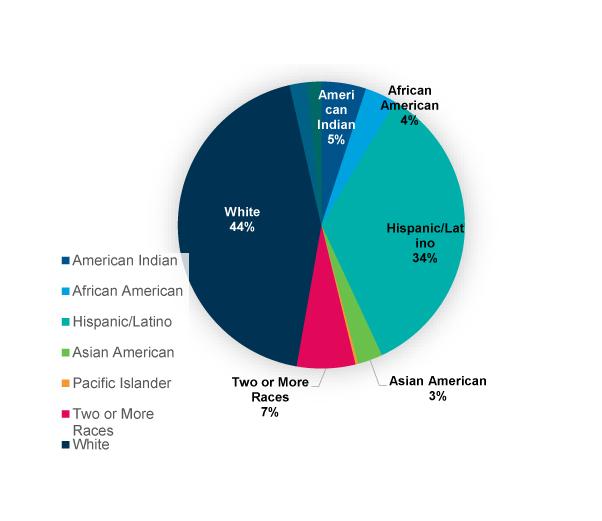You are here
2.2 - Serving a Diverse Student Population
HSU offers a world-class education to the state’s diverse and underserved populations. A fundamental goal of the California State University System’s 2025 Graduation Initiatives is to reduce opportunity gaps for traditionally underrepresented and first-generation students, and to promote a diverse student body. In pursuit of this mission, HSU has made great improvements in the education it provides to many of Humboldt’s most underrepresented communities. Following the trend of most colleges sine the 1970’s 4, HSU has about 1,00 more female than male students. In Fall 2018 approximately 50% of HSU’s student population were students of color.41 In fact, from 2010 to 2016, the number of students from traditionally underrepresented groups increased by 85%.42 In 2013 HSU was recognized as a Hispanic Serving Institution (HSI), and as such received a $3 million federal HIS-STEM grant to support place based leaning in the College of Natural Resources and Science. 43
HSU serves the highest proportion of Native American students in the CSU system.44 While the HSU demographic report shows that only about 1% of the student population is Native American, federal reporting guidelines often cause American Indian/Native American populations to be underreported. When examining all ethnicities students may self-select, HSU’s American Indian/Native American enrollment is about 5%.45 Figure 1 displays the breakdown of student ethnicities in the Fall of 2018.
Figure 1: Fall 2018 Student Ethnicity

HSU has several programs that are specially aimed at advocating for and supporting Native American students. The Indian Tribal and Educational Personnel Program (ITEEP) supports HSU’s many Native American students within the Arts, Humanities and Social Science, Natural Resources and Sciences, and Professional studies colleges. ITEEP staff assists students to build networks on and off campus, connect with tribal representatives, set career goals, and apply for scholarships, internships and graduate schools. HSU has also recently worked on increasing the number of Native American faculty members on staff, reinstated the President’s Native American Advisory Committee in 2016, and has been increasing University focus on recruiting local Native American students.46
In 2017, over 55% of HSU students were first generation college students, and 54% were low income.47 To support first generation and low-income students in particular, HSU has Student Support Services (SSS) and the Educational Opportunity Program (EOP). The SSS program focuses on assisting students considering continuing on to graduate or professional schools. The program provides financial aid, advising, mentoring, and career support services to low income and first-generation HSU students. In 2015, HSU received the $1.87 million Federal TRiO grant from the US Department of Energy (DOE) to fund the SSS program. The EOP program “serves as a primary vehicle for the CSU in increasing the access, academic excellence and retention of California's educationally and economically disadvantaged students.”48 Over 90% of students in the program are first generation college students, and 60% are members of ethnic groups underrepresented in higher education.
Over half of the HSU student population are students of color, 55% are first-generation students, and 54% are low-income.
- 40 Forbes. The Male-Female Ratio in College. 2012. https://www.forbes.com/sites/c...
- 41 HSU. Enrolled Student Demographics Report Options. https://pine.humboldt.edu/~ans...
- 42 HSU Graduation Initiative 2025: Academic Year 2017-18. https://grad2025.humboldt.edu/...
- 43 HSU. We Are Here. A Snap Show of HSU’s Current Conditions, Circumstances, and Influences, 2018. https://ie.humboldt.edu/sites/...
- 44 HSU. Vacancy Announcement. 2018. https://hraps.humboldt.edu/sit...
- 45 HSU. We Are Here. A Snap Show of HSU’s Current Conditions, Circumstances, and Influences, 2018. https://ie.humboldt.edu/sites/...
- 46 HSU. We Are Here. A Snap Show of HSU’s Current Conditions, Circumstances, and Influences, 2018. https://ie.humboldt.edu/sites/...
- 47 HSU. Fast Facts 2017. https://ie.humboldt.edu/fast_f...